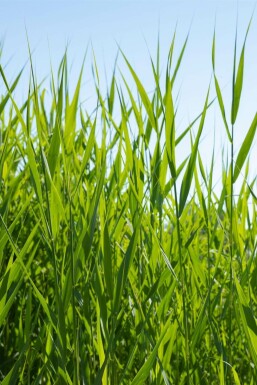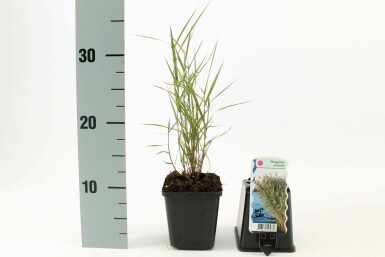

200cm




Updated on 10 September 2025
We regret to inform you that we are currently unable to ship orders to the United Kingdom. We anticipate being able to resume shipments at the beginning of 2026.
Phragmites are ideal for natural garden projects. They enhance biodiversity and provide winter structure. Perfect for pond edges and marsh zones, this vigorous grower acts as a natural screen and improves water quality, serving as an effective water purification solution.


200cm




Phragmites transforms any garden with its striking presence. This reed-like grass, featuring long hollow stems and narrow, gray-green leaves, creates a tall clump perfect for adding height to garden spaces. Blooming from July to September, its large brown-purple plumes captivate the eye. Ideal for pond edges and reed beds, it aids in water purification and creates natural screen cover. For those in the UK looking to enhance their wetland garden, it offers an excellent solution. Discover how Phragmites can elevate your garden's appeal and functionality. Whether for its aesthetic charm or practical benefits, this reed plant is a valuable addition to any landscape.
Phragmites, commonly known as common reed, is a tall perennial grass found in many gardens and natural habitats. It is also called Phragmites australis, wetland grass, and screening reed. This plant is widely used for waterside planting, pond edges, and marsh zones. Phragmites belongs to the Poaceae family and can be found worldwide, especially in temperate climates. The common reed plays a crucial role in nature by stabilising riverbanks, providing nesting sites for birds, and filtering water. Its name comes from the Greek word phragmōn, meaning hedge or partition, symbolising protection and modesty. It has historical uses in thatched roofs and rituals. The lifecycle of Phragmites involves growing rapidly in wet, nutrient-rich soils, thanks to its rhizomes. It is a deciduous grass that is important for riparian ecology. Its ecological value makes it a significant choice for any natural garden. If seeking erosion control and wildlife value, consider the common reed. For those interested in adding it to their garden, options to buy Phragmites in the UK are available, especially for pond edge and reed bed planting.
Phragmites is a native perennial often found along wet banks. This tall, reed-like grass grows quickly, reaching heights between 150 cm and 400 cm. The underground rhizomes allow it to spread effectively. Phragmites thrives in wet, nutrient-rich soils, contributing significantly to riparian ecosystems as erosion control and wildlife value are notable aspects. During its development, Phragmites starts with shoots that emerge rapidly in spring. As summer approaches, it forms tall, hollow stems and narrow, gray-green leaves. By July, the plant begins to bloom, showcasing large, feathery plumes. These plumes exhibit a range of colours from purple-brown to silvery grey, influenced by factors like soil type and light. The blooming period extends through September, with temperature and care impacting the intensity and duration of the display. The common reed is not primarily known for its scent, but its presence adds diversity to garden spaces. Mature Phragmites can reach up to 400 cm, depending on species, location, and care. This makes it ideal for waterside planting, pond edges, and natural gardens. It's a valuable addition for those interested in marginal vegetation and reed plant landscaping.
Phragmites features linear, elongated leaves with a unique sharp or pointed tip. Their colour varies between blue-green and grey-green, adapting well to wetland habitats. Spreading through underground rhizomes, Phragmites is highly tolerant of flooding and nutrient-rich soils. This grass remains an essential part of the landscape due to its reed-like structure, providing natural filtration and ecological support for aquatic life. Importantly, it is not toxic, making it safe for children and pets, and is very suitable for ponds and marshy gardens.
Winterhard, Phragmites withstands temperatures from -34°C to -23°C, thriving in USDA zones 4 to 6. Its cold resilience makes it ideal for marshy areas, where it remains effective even during harsh winters. This plant retains some structure throughout the year, although it does lose its leaves annually. While not evergreen, it continues to play a significant role in habitat restoration.
Phragmites excels in summer heat and tolerates drought conditions due to its deep-rooted system. Its leaf structure and surface aid in reducing water loss, allowing it to withstand dry spells effectively. The presence of wind does not significantly affect Phragmites, thanks to its strong, reed-like form.
This plant also boosts biodiversity by attracting various species and offering shelter and food. Its late-summer flowers contribute to the garden's aesthetic while enhancing the ecosystem's balance. Gardeners in the UK often grow Phragmites australis for habitat restoration, benefiting both gardens and wildlife alike.
Phragmites, a type of tall, wetland grass, is an excellent choice for creating a natural look in gardens with water features. Known for its ability to grow in moist environments, it offers both beauty and function to any outdoor space. Integrating Phragmites can enhance the aesthetic and ecological value of your garden.
Phragmites is perfect for adding height and natural movement as a tall ornamental grass in the garden. It combines beautifully with other aquatic plants, creating a balanced ecosystem. One great companion is Typha, which thrives in wet areas and complements Phragmites. Together, they create a lush, soothing environment. The vibrant yellow blooms of Iris pseudacorus add a splash of colour and contrast nicely with the green reeds. Lythrum, with its striking purple flowers, offers a beautiful visual blend and attracts pollinators. Alisma, known for its small white flowers, pairs well with Phragmites, softening the tall grass with delicate blooms. Caltha palustris, or marsh marigold, provides bright yellow flowers, enhancing the pond edge with cheerful hues. These combinations not only provide aesthetic appeal but also support biodiversity. They create habitats for wildlife, improve water quality, and stabilise pond banks. Choosing Phragmites and its companions gives a natural look, offering both beauty and environmental benefits. These plants thrive together, making them ideal for water purification and natural riverbanks. Implementing these combinations helps achieve a harmonious aquatic setting with vibrant life and colour.
Common reed thrives when planted in spring or autumn. Planting is best in moist conditions as Phragmites prefers waterlogged to marshy soil. It's important to use a root barrier, especially since it spreads via underground rhizomes. Plants in pots can be planted year-round, avoiding frost. Wet, nutrient-rich clay or peat is ideal, with at least 6 hours of sun a day. When planting common reed, consider spacing based on plant type and growth rate. Taller clumps require more space, and the number of plants per metre can be found on the Heijnen product page. Adequate spacing ensures healthy growth and room for spreading. Prepare the soil by ensuring it's nutrient-rich and capable of retaining moisture, as common reed grows well in such conditions. It's recommended to use Heijnen planting soil for optimal results. During planting, ensure the soil is well-drained and moist, and water the Phragmites regularly. This is especially important during the initial stages. Fertilising may be necessary to support the plant's vigorous growth. For the best results, plant near pond edges or similar environments.
Phragmites offers a striking appearance in any garden with its tall, reed-like structure. The leaves of this plant display a lovely blue-green to grey-green colour, creating a soothing visual harmony. One of the main attractions is its beautiful blooms. The panicles vary in shades of purple-brown, silvery grey, and red-brown, which provide interest through the seasons. During autumn, Phragmites transitions gracefully, adding a touch of colour as it changes. In winter, the structure of this plant stands strong, offering a fascinating texture when touched by frost. The common reed is not just visually appealing but also ecologically significant. It supports aquatic life and contributes to natural filtration processes. Phragmites is a reed-like garden plant for pond edges. As a tall clump, it provides an ideal shelter for various garden wildlife, making it an excellent choice for enhancing biodiversity. The movement of Phragmites in the wind creates a dynamic landscape element, adding to its appeal. With its rhizome growth, it is perfect for natural screens, offering privacy where needed. This wonderful plant is well-suited for areas requiring water purification and improves the overall ecology of the garden.
Phragmites, often used in gardens and natural landscapes, offers several advantages and a few challenges. Here’s a closer look:
Advantages:
Disadvantages:
Proper soil preparation and placement, along with correct care and timely fertilisation, reduce the risk of diseases and pests. Regular maintenance ensures healthy growth and optimal blooming for Phragmites.
Phragmites is a top choice for anyone wanting to enhance their garden's pond edge or create a natural reed bed. As an excellent option for water purification and erosion control, Phragmites is known for its vigorous growth and ability to act as a strong natural screen. The common reed not only aids in improving biodiversity but also provides a sturdy structure throughout the year, especially noticeable with its flowers arriving in late summer. Heijnen offers a fantastic selection of Phragmites, perfect for those looking to buy Phragmites in the UK. These plants are not just decorative but functionally enhance the root spread and wildlife value of any water feature or natural riverbank. By adding Phragmites to your garden, benefit from their eco-friendly qualities and enjoy the lively habitat they help create. Order Phragmites (Reed) from Heijnen and create natural edges around your pond or ditch with this native ornamental plant.
We would like to provide some tips on how to plant and care for a Phragmites. By following these tips, you can be sure to enjoy your Phragmites for a long time.
Phragmites thrives in wet, nutrient-rich clay or peat soils with full sun exposure. It is essential for this plant to have at least 6 hours of direct sunlight each day to ensure healthy growth. Planting in moist conditions during spring or autumn is ideal. The correct location provides better growth, vibrant foliage, and increased resistance to environmental stress. Phragmites grows best in well-drained, yet moist soil, making it perfect for environments that experience flooding. It is commonly used around ponds, marsh zones, or as a natural garden element. The plant spreads via underground rhizomes, making it an excellent choice for natural riverbanks, water purification, and as a windbreak. Regular pruning in early spring encourages new growth. Choosing the right spot is crucial for the vitality and bloom of Phragmites, as an appropriate environment leads to a healthier, more robust plant.
Proper soil preparation is key when planting Phragmites. Begin by cultivating the soil to improve its structure. This ensures water can drain easily and roots can access nutrients. Mixing organic material like compost into the earth boosts nutrient content, aiding plant growth. For Phragmites, a wet, nutrient-rich environment is ideal. Proper soil preparation leads to better establishment of strong root systems, which is crucial for healthy growth. Pot-grown plants can be planted all year, except when it's frosty, while those with burlap root balls are best planted in spring or autumn. After planting, water the Phragmites regularly until they are well-established. Plant size affects spacing; larger plants require more space. Set them in full sun for at least six hours daily for optimal growth. Properly prepared soil ensures vigorous growth and healthy plants.
Fertilising Phragmites is crucial for promoting robust growth and vibrant health. Enhancing vitality not only supports lush foliage but also encourages dynamic blooming of purple-brown and silvery grey panicles. Using organic or organic-mineral fertiliser from Heijnen can significantly benefit Phragmites. These fertilisers improve soil health, which is essential for the wellbeing of this wetland grass. Fertilising twice a year, in spring and summer, is advisable. It’s important to adjust the amount based on the size of the plant; larger plants need more nutrients. Fertilisers need water to activate, so during dry spells, watering after application is necessary to ensure nutrients reach the roots. Phragmites thrive best near water bodies, where soil moisture supports nutrient uptake. Proper fertilisation maximises the common reed’s potential in natural gardens, marsh zones, and as a windbreak.
Phragmites should be pruned to maintain its shape and control its growth. This is particularly important if used for screening or in small gardens where space is limited. Pruning helps to remove old stems and flowers, promoting new growth and enhancing the plant's health. For best results, prune Phragmites in early spring. This timing allows the plant to focus its energy on developing strong new shoots. It is recommended to mow back to 10–20 cm in February. Use sharp secateurs to ensure clean cuts and avoid damaging the plant. Good quality tools are essential as they make the job easier and more efficient. Regular maintenance keeps Phragmites in check, preventing it from spreading too aggressively in the garden. Remember to apply a root barrier if it is planted in restricted areas to control its vigorous growth.
Phragmites thrives in wet, marshy conditions and requires a lot of water. When first planting, it is crucial to ensure a constant water level to help it root properly. Once established, Phragmites only needs watering during prolonged dry spells. It's best to water deeply rather than giving a little each day. Watering is most effective early in the morning or late in the afternoon to minimise evaporation. Always check the soil before watering to determine if it is truly necessary. Ensure excess water can drain away, whether the plant is in the ground or in containers. Drip irrigation is effective once Phragmites is well rooted, but during initial planting, it’s important to water directly. This plant has very low drought tolerance and dries out quickly, so maintaining the right moisture level is essential for its health.
Phragmites is a tall, grass-like plant often found in wetlands and ponds. Known for its reed-like structure, it provides natural filtration and supports biodiversity. This plant is historically significant, used in thatched roofs and rituals, symbolising protection and modesty. It is not toxic to children or pets, making it a safe addition to gardens. Common reed enhances water purification and offers excellent winter structure, acting as a natural screen with its vigorous growth.
Phragmites can be propagated by dividing rhizomes. This process is important for rejuvenating the plant and removing old parts. By splitting large clumps, the plant remains healthy and vibrant in the garden. Dividing also helps control size and allows for multiplication of the common reed. To divide, dig up the plant, remove old sections, and replant young parts. It is best done every few years, either in spring or autumn, with a preference for autumn. Use a spade or sharp knife for clean cuts. This method ensures robust growth and maintains the plant's vitality. Regular division supports the overall health and spread of Phragmites, making it a valuable addition to any garden.
Common reed is a tall wetland grass with long hollow stems and narrow grey-green leaves. Its striking purple-brown plumes bloom July to September. Known for water purification and biodiversity enhancement, it offers winter structure and acts as a natural screen. Buy Phragmites (common reed) from Heijnen to stabilise riverbanks and attract birds. Ideal for creating natural pond edges.
